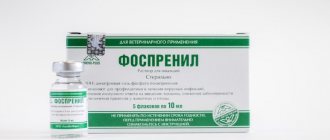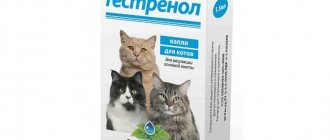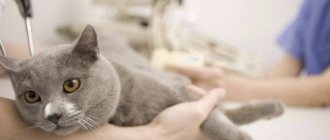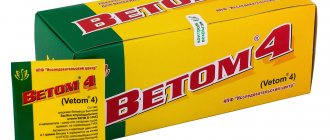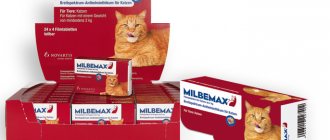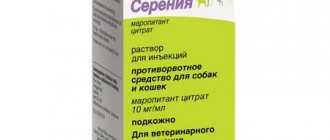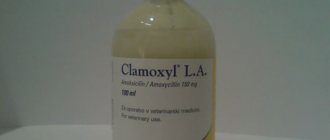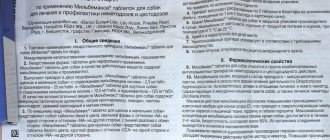Composition and release forms
The active substances that make up the drug Globfel-4 are beta and gamma globulins from the blood of some animals (goats, horses or oxen) with antibodies to calicivirus, infectious rhinotracheitis (or feline herpes), panleukopenia (or feline distemper) and chlamydia . Available in 1 ml bottles (1 dose), in the form of liquid for injection. Externally, the product looks like a transparent or odorless opalescent solution, the color of which varies from transparent to pale yellow. There may be a small amount of sediment at the bottom of the bottle, which dissolves very quickly when shaken.
Advantages and disadvantages
One of the disadvantages is the inconvenience of transportation - so that the product does not lose its active qualities, the manufacturer recommends transporting Globfel-4 with a cold pack.
The advantages:
- Relatively low cost, due to the fact that the developer is located in Moscow and the drug is not exportable.
- Efficiency.
Contraindications
No
Side effects
Possible (but not required) are an increase in body temperature after the injection and the appearance of allergic reactions.
Indications for use
Globfel is widely used in veterinary medicine for preventive vaccination and treatment of:
panleukopenia (feline distemper); calcivirosis; acute respiratory rhinotracheitis; chlamydia.
Panleukopenia, or more commonly known as feline distemper, affects the nasopharynx and gastrointestinal tract of felines. The risk of infection for a pet is very high, since literally the owner’s shoes serve as a carrier of the disease. A timely injection of Globfel-4 serum stops the infection.
Calicivirus infection, or feline calicivirus, affects the upper respiratory tract against the background of a febrile syndrome and the formation of ulcers in the mouth and on the tip of the nose. Treatment of calcivirosis with Globfel is carried out as part of complex antiviral therapy.
Acute respiratory rhinotracheitis is also called feline herpes. Its danger lies in the fact that even cats that have recovered from the disease remain carriers of the disease for about 9 months. Infection occurs through any, even indirect, contact with a cat carrying the virus. The disease affects the eyes and respiratory organs. Ideally, it is necessary to carry out preventive vaccination, but even if your pet is sick, Globfel therapy brings good results, especially in the initial stages of the disease.
Chlamydia is a disease caused by chlamydia entering the body. Foci of damage are the respiratory organs, eyes, gastrointestinal tract and genitourinary system. The use of serum helps to alleviate the symptoms of the disease and also rids the body of its pathogens.
Advantages
Globfel-4 is an innovative drug used for preventive measures and the fight against dangerous infectious diseases in cats. The main advantages of the drug are:
- Wide range of effects;
- Increased efficiency;
- possibility of use as part of complex therapies;
- cannot cause symptoms of illness if dosages are exceeded;
- no side effect;
- Use for cats of any age;
- there is no additional component, that is, the toxin cannot accumulate in the body;
- short course of use.
Globfel-4 is a serum against viral infections in cats and kittens.
Instructions for use
The drug is administered subcutaneously. To avoid anaphylactic reactions to immunoglobulins, an antihistamine should be given to the sick pet 10–15 minutes before the injection.
To prevent infectious and viral diseases and strengthen the immune system, the serum is used once in the following dosage: for animals whose weight does not exceed 10 kg, the drug is administered subcutaneously in a volume of 1 dose (1 ml); if the cat's weight exceeds 10 kg, the dose is doubled (2 ml).
When using Globfel for medicinal purposes, the dosage remains the same. A total of 2 to 4 injections are given, keeping an interval between them from 12 hours to 1 day.
The maximum effect is observed when taking Globfel in the initial phase of the disease. It is recommended to carry out therapy with Globfel-4 together with symptomatic treatment, in combination with antibacterial and vitamin preparations, as well as probiotics.
Before preventive vaccination, it is recommended to carry out antiparasitic and anthelmintic therapy.
Prophylaxis with Globfel-4 should not be carried out on a weakened animal.
The drug must be stored in a dry, dark place at a temperature of 2 – 8 C. Immediately before use, warm to room temperature.
Self-injections of Globfel to a cat
Since the drug is used through injections that are injected into the animal’s body, you should carefully study the question of where to inject Globfel into a cat. It is worth noting that for greater effectiveness of the drug, your pet should be prepared.
There are certain preparation rules:
- A week before using the drug, it is worth carrying out procedures aimed at preventing parasites and worms.
- It is necessary to make sure that the pet is not sick with any diseases, since Globfel is more aimed at a preventive effect.
- Before the injection, the cat should be calm, just like its owner. After all, in a restless state it will be much more difficult to give an injection.
It should be understood that using this drug without carefully studying how to administer Globfel to a cat is dangerous. Before using this drug, you should study the instructions for use and consult a veterinarian.
Let's look at some features of the injection:
- It is recommended to administer the medicine with a disposable syringe and needle.
- The drug is administered into the cat's body by injecting it into the femur or under the withers of the pet.
- It is necessary to carefully observe the dosage of the drug, which may vary depending on the weight of the animal.
- The drug is administered only once a day for preventive measures and two to three times for treatment.
- The drug should be injected only after the animal has been examined by a specialist.
Reviews
Inessa:
When my cat suddenly started sneezing, I admit, I didn’t pay much attention to it. But the next day her eyes began to water and she developed a runny nose. At this point I sounded the alarm and took her to the vet. My kitty was diagnosed with rhinotracheitis. The doctor prescribed a comprehensive treatment for us with Globfel. We injected it for 4 days, with a 12-hour break between injections. I had to give the injections myself, so as not to torment the poor animal with trips on public transport. After the first injection, the cat felt noticeably better, and a week later, during a follow-up examination, the veterinarian confirmed that we had recovered.
Arina:
We picked up a small kitten on the street. We decided to keep him and, of course, the next day we took him to the veterinary clinic. In addition to treatment for worms and fleas, the veterinarian strongly recommended piercing Globfel-4 for 10 - 15 days, since the animal spent a long time on the street and could pick up anything. The injection schedules were outlined for us. They injected the drug on their own, before the injection they gave the cat a crushed tablet of suprastin to avoid anaphylactic shock. Everything went well, the cat is healthy, and there were no side effects from using Globfel.
Magda:
The kitten was prescribed this drug, but after the injections his breathing quickens and he becomes drowsy. This is fine?
Fedor:
We took our Frosya to the veterinary hospital after she had been sneezing and “sniffling” non-stop for 24 hours. The specialist who examined her said that the cat was infected with feline herpes, or rhinotracheitis. Prescribed by Globfel. After 4 days, Frosya should have been brought in for an examination. My wife, a nurse by profession, did the injections. There were a lot of problems with the injections, but it was worth it. A week later the cat recovered. We believe that the medicine helped.
Stanislav:
We found a small kitten in the entrance. We consulted with a veterinarian we know, who advised us to give him a one-time injection of Globfel. We were all very scared when, after the injection, the baby began to vomit severely and then have diarrhea. It turned out that before vaccination it was necessary to give the cat some kind of antihistamine. It's good that everything worked out!
To whom is it assigned?
The drug is used for the treatment and prevention of a dangerous disease in pets – chlamydia.
In the course of numerous studies regarding the pharmaceutical drug "Globfel-4", it was found that its therapeutic activity extends to the following infectious diseases:
- Chlamydia. It is a bacterial infection that, after entering the cat’s body, provokes a rise in body temperature, coughing, discharge from the nasal cavity and organ of vision, and also causes the pet to refuse to eat.
- Rhinotracheitis. An illness caused by the herpes virus and causing difficulty breathing, rhinitis, impaired bowel movements, swelling of the pharynx and high body temperature.
- Calcivirosis. An infectious lesion of the cat's respiratory system, which is characterized by a febrile state of the animal, shortness of breath, apathy, diarrhea, ulcerations on the tongue and nose.
- Panleukopenia. Infection of an animal with the FPV paravirus, resulting in the pet vomiting, diarrhea, lethargy and experiencing poor coordination.
Analogs
Vitafel Globulin, Vitafel-S are almost complete analogues of Globfel. These drugs are used intramuscularly, subcutaneously or intravenously.
Multifel-4 is indicated for use in the same cases as Globfel-4. However, the principle of action of these drugs is different. The active substances of Multifel are weakened antigens of the above viruses, i.e. It cannot be used to treat sick animals. This drug also has more side effects than Globfel.
Operating principle
After injecting cats with the drug GLOBFEL-4 for prophylactic purposes, animals develop passive immunity to the pathologies listed above. It is stored for 14 days, after which the pets receive the necessary vaccinations. This ensures that they develop stable immunity to viruses.
GLOBFEL-4 also has therapeutic properties. They manifest themselves to the maximum if the medicine is used during the incubation of the disease and during the following prodromal period.
Clinical and immunological effectiveness of imunofan in opportunistic infections
A. V. Karaulov, Doctor of Medical Sciences, Professor
MMA im. I. M. Sechenova, Moscow
A new immunoregulatory peptide, imunofan, is a synthetic derivative of the hormone thymopoietin (arginyl-a-aspartyl-lysyl-valyl-tyrosyl-arginine). In a short time, it was studied in detail and introduced into clinical practice as a means of pathogenetic therapy. The success of Imunofan is largely determined by its origin (a third-generation drug based on synthetic immune hormones), a detailed study of the mechanism of action and a clear rationale for clinical use [1, 2].
In our clinic, the mechanisms of action of the drug and its clinical effectiveness in respiratory diseases have been studied for a decade. In particular, the clinical effectiveness of imunofan in chronic bronchitis was successfully demonstrated [3]. In continuation of these works, Professor N.A. Didkovsky was the first to identify the interferon-inducing property of immunofan, which served as another basis for its use in opportunistic infections. We used Imunofan in the treatment of 28 patients with chronic respiratory infection (chronic pharyngotracheitis, chronic bronchitis of chlamydial bacterial etiology) with severe dysfunction in all parts of the immune system, including inhibition of the induced production of interferon a and g (INF-a and -g) . The drug was prescribed 1 ml of 0.005% solution intramuscularly every two days, 10 injections per course of treatment. The drug was well tolerated. In a number of patients, after three to five injections, a moderate exacerbation of the inflammatory process was noted, which, as a rule, stopped on its own. The clinical effect of the drug was expressed in the disappearance of purulent sputum and other symptoms of respiratory infections, as well as in an improvement in general well-being and a noticeable increase in performance already at the beginning of treatment. It turned out that after a course of therapy with Imunofan, in the majority of patients (70%), the virus-induced production of IFN-a (previously reduced) increased by 2-6 times and the mitogen-stimulated production of IFN-g by 2-4 times, including in response to FGA. The effect of the therapy persisted for a long time and was more pronounced in particularly severe cases of the disease, when basic therapy was unsuccessful or immunotherapy that preceded our treatment was ineffective. The drug was easily tolerated, its use was accompanied by pronounced positive changes according to immunological examination tests in patients with initially altered immunity parameters.
According to other clinical observations that we carried out during the outpatient treatment of patients, Imunofan has established itself as a drug that also has anti-inflammatory activity, which was reflected in a more rapid normalization of the symptoms of respiratory opportunistic infections. A peculiarity of its use at this stage of treatment was the need for repeated courses of therapy over three months of observation. At the same time, courses of therapy were often prescribed in the absence of changes in the immune status, but in the presence of clinical manifestations of infection. Imunofan combined well with therapy used to treat concomitant diseases (coronary heart disease, gastrointestinal diseases, obstructive pulmonary diseases). Moreover, in a number of cases, synergism in the action of drugs was observed (when combined with anti-inflammatory drugs, cholesterol-lowering drugs, etc.).
An assessment of the condition of patients with opportunistic infections, such as cytomegalovirus (CMV) infection, toxoplasmosis, chlamydia, pneumocytosis, herpes infection, cryptosporidiosis, listeriosis, occurring against the background of an immunodeficiency state, and the use of imunofan for them was carried out at the Omsk Medical Academy. In these fairly extensive studies, 202 patients with various opportunistic infections were observed. The criterion for inclusion in the study was the presence of a typical clinical picture of the disease, confirmed by laboratory tests. Each patient underwent a full range of laboratory and instrumental studies.
The study group of patients (102 people) received treatment with imunofan against the background of basic therapy. The drug was used in the form of intramuscular injections once every two days - 5 injections, then once every four days - 5 injections. If necessary, the course of treatment could be increased to 15 doses.
Patients in the comparison group (100 people) received etiopathogenetic treatment (basic therapy), including an immunomodulatory complex (adaptogens, enterosorbents, UV rays and hemosorption).
Lymphadenopathy, arthralgomyalgia, low-grade fever, complaints of general weakness are characteristic of all opportunistic infections. Therefore, when assessing the therapeutic effectiveness of imunofan, its result was assessed according to the main syndromic manifestations of opportunistic infection.
Thus, the administration of the drug to patients stimulates the metabolic reactions of phagocytic cells, which is especially important for chronic viral infections (CMV, herp infection), accompanied by immunocomplex reactions. The use of Imunofan contributed to the restoration of the total number of lymphocytes. At the same time, the patients showed an improvement in the balance of lymphocyte subpopulations, which demonstrates an increase in IRI from 0.8±0.1 to 1.75±0.3 after completion of the course of treatment with imunofan.
Increased phagocytic activity and restoration of the balance of T-lymphocyte subpopulations in patients receiving imunofan are accompanied by positive dynamics on the part of the CEC, which, under certain conditions, are pathogenetic factors of inflammation, damage and the development of allergic exogenous alveolitis or glomerulonephritis.
The damaging effect is usually caused by soluble complexes formed in a small excess of antigen. In these cases, the damaging effect of the complex is realized mainly through the activation of complement, the release of lysosomal enzymes, the generation of superoxide radicals and the activation of the kallikrein-kinin system. Complexes formed in tissues are usually retained at the site of their formation, and in the case of acute or chronic infection they are found in the vessels of the glomerular apparatus of the kidneys, alveolar vessels, their basement membranes and surrounding tissue. The topography of CEC deposition is determined by the state of vascular permeability: where it is increased, the predominant deposition of CEC occurs. Thus, when CEC is deposited in the lungs, alveolitis occurs, and in severe cases, inflammation can take on an alternating character with tissue necrosis, hemorrhage, and partial or complete thrombosis is possible in the vessels.
Circulating immune complexes become pathogenic only under certain conditions, in the case of their prolonged circulation and disruption of the mechanisms by which the blood is cleared of complexes. The latter occurs when the phagocytic function of the RES is inhibited as a result of its overload.
Analysis of the data obtained on the effect of imunofan on the immune status of patients with opportunistic infections shows that the drug stimulates the phagocytic and T-cell immunity, enhances the elimination of CEC and does not have an allergenic effect.
The positive effect of imunofan on the immune response in patients was accompanied by its pronounced effect on the clinical course of the infectious process. The data obtained convincingly indicate that Imunofan enhances the antitoxic basic therapy of multiple organ pathologies and concomitant diseases, which is reflected in a reduction in the period of manifestations of certain clinical syndromes. With the use of Imunofan, patients noted the disappearance of weakness, normalization of sleep and mood, and improvement of appetite. There were no side effects from the administration of the drug to patients.
Literature.
- Imunofan - a regulatory peptide in the treatment of infectious and non-infectious diseases / Ed. V. I. Pokrovsky. M., 1998. P. 119.
- Karaulov A.V., Sokurenko S.I. Imunofan: immediate and long-term results of treatment of patients with chronic bronchitis // Medical Market. 2000. No. 34. pp. 21-24.
- Karaulov A.V. // Attending physician. 2000. No. 4.
Storage conditions
Globfel 4 must be stored in a dry, dark place at a positive temperature of 2–8 °C. The storage location must be inaccessible to children and pets. After the expiration of the shelf life (2 years), the drug cannot be used.
If the drug turns out to be defective, the ampoule must first be boiled for 15 minutes and then thrown into the trash. This is done in several cases:
- A foreign substance was found in the medicine.
- The bottle or substance is moldy.
- The sediment does not break up when shaken.
- The color of the medicine has changed.
- The drug's shelf life has expired.
- There are no labels on the bottle.
- The vial has been frozen (below +2°C) or overheated (above +8°C).
- The seal of the bottle was broken.
- The drug was opened but not used.
Whey should be stored separately from food and feed. The best place to store Globfel 4 would be a closed shelf in a closet or a general first aid kit with other medications. Whey cannot be frozen, so it has no place in the refrigerator.
Before administering Globfel, the cat is injected with an antihistamine.
